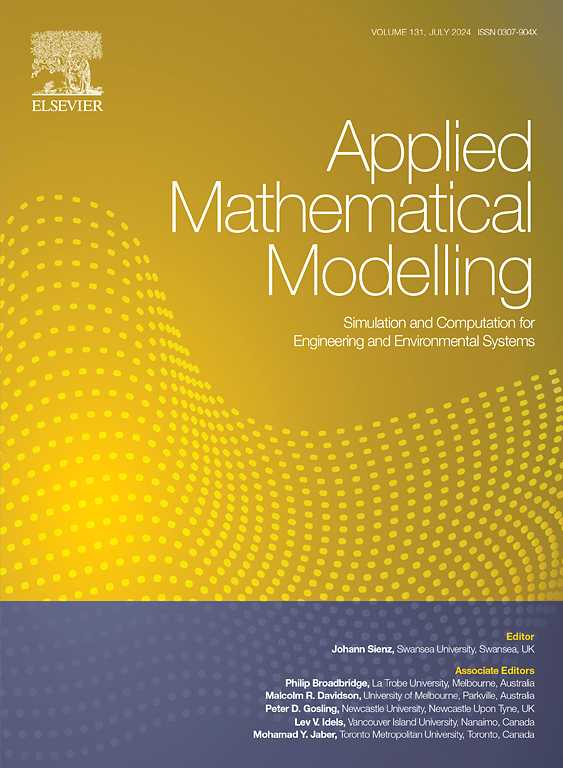金属粉末床熔合过程中柱向等轴过渡的半解析模型
IF 4.4
2区 工程技术
Q1 ENGINEERING, MULTIDISCIPLINARY
引用次数: 0
摘要
柱向等轴转变是粉末床熔合金属件组织设计和力学性能优化的关键。有效地了解各种工艺条件下的CET行为是至关重要的。然而,pbf合金的工艺参数、孔隙率和CET之间的直接关系尚不清楚。为了解决这个问题,本文开发了一个集成的半解析建模框架,以有效地表征多组分合金在不同工艺设置下的CET行为。基于微分正交法结合混合规律,首次对多组分合金在PBF过程中的热行为进行了预测。随后,综合制定了热致孔隙度、元素扩散、快速凝固、过冷和成核分布,以分析捕获pbf构建的多组分合金中的热致孔隙度。通过与已有报道的五种典型多组分合金在PBF过程中的CET行为进行比较,验证了预测模型的正确性。分析了影响金属PBF过程中热致效应的关键工艺参数,包括能量密度、预热温度、热源尺寸、零件尺寸和成分含量。结果表明,工艺相关热梯度与凝固速度的比值对金属PBF过程中的CET起主导作用。当采用较高的能量密度或较低的预热温度时,凝固过程中等轴晶粒的生长受到明显抑制。相反,由于热梯度的减小,等轴晶粒的生长随着成形件长厚比和热源尺寸的增大而加快。此外,陶瓷颗粒的加入可以促进金属PBF固结过程中的CET。研究结果可为设计和打印具有理想力学性能的多组分合金提供指导。本文章由计算机程序翻译,如有差异,请以英文原文为准。
Semi-analytical modeling columnar-to-equiaxed transition during metal powder bed fusion
Columnar-to-equiaxed transition (CET) is crucial to the microstructure design and mechanical performance optimization of metallic parts via powder bed fusion (PBF). It is essential to effectively understand the CET behavior under various process conditions. However, the straightforward relation between process parameters, porosity, and CET of PBF-built alloys remains unclear. To address this, this paper develops an integrated semi-analytical modeling framework to efficiently characterize the CET behavior of multicomponent alloys under various process settings. The thermal behavior of multicomponent alloys during PBF is first predicted based on the differential quadrature method combined with the rule of the mixture. Subsequently, the thermal-induced porosity, element diffusion, rapid solidification, undercooling, and nucleation distributions are comprehensively formulated to analytically capture the CET in PBF-built multicomponent alloys. The predicted model is validated by the comparisons with the reported CET behaviors of five typical multicomponent alloys during PBF. Additionally, the crucial process parameters on the thermal-induced CET during metal PBF are demonstrated, including the energy density, preheating temperature, heat source dimension, part dimension, and compositional content. The results show that the ratio of process-related thermal gradient and solidification velocity plays a dominant role in the CET during metal PBF. When higher energy density or lower preheating temperature is used, the growth of equiaxed grains is significantly suppressed during solidification. In contrast, due to the reduction in thermal gradient, the growth of equiaxed grains is promoted with the increasing length-to-thickness ratio of as-built parts and heat source dimensions. In addition, the addition of ceramic particles can promote CET in the consolidation process of metal PBF. The findings can serve as a guideline for the design and printing of multicomponent alloys with desired mechanical properties.
求助全文
通过发布文献求助,成功后即可免费获取论文全文。
去求助
来源期刊

Applied Mathematical Modelling
数学-工程:综合
CiteScore
9.80
自引率
8.00%
发文量
508
审稿时长
43 days
期刊介绍:
Applied Mathematical Modelling focuses on research related to the mathematical modelling of engineering and environmental processes, manufacturing, and industrial systems. A significant emerging area of research activity involves multiphysics processes, and contributions in this area are particularly encouraged.
This influential publication covers a wide spectrum of subjects including heat transfer, fluid mechanics, CFD, and transport phenomena; solid mechanics and mechanics of metals; electromagnets and MHD; reliability modelling and system optimization; finite volume, finite element, and boundary element procedures; modelling of inventory, industrial, manufacturing and logistics systems for viable decision making; civil engineering systems and structures; mineral and energy resources; relevant software engineering issues associated with CAD and CAE; and materials and metallurgical engineering.
Applied Mathematical Modelling is primarily interested in papers developing increased insights into real-world problems through novel mathematical modelling, novel applications or a combination of these. Papers employing existing numerical techniques must demonstrate sufficient novelty in the solution of practical problems. Papers on fuzzy logic in decision-making or purely financial mathematics are normally not considered. Research on fractional differential equations, bifurcation, and numerical methods needs to include practical examples. Population dynamics must solve realistic scenarios. Papers in the area of logistics and business modelling should demonstrate meaningful managerial insight. Submissions with no real-world application will not be considered.
 求助内容:
求助内容: 应助结果提醒方式:
应助结果提醒方式:


